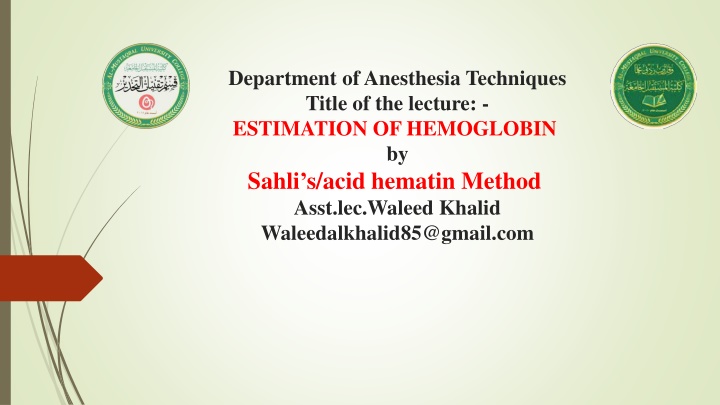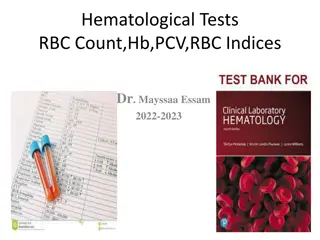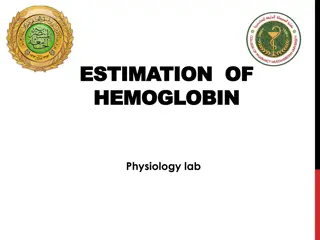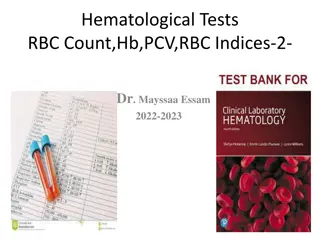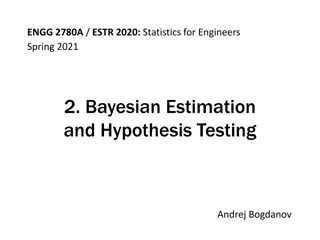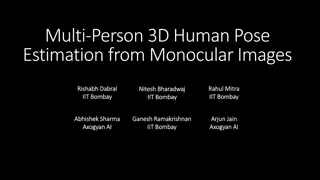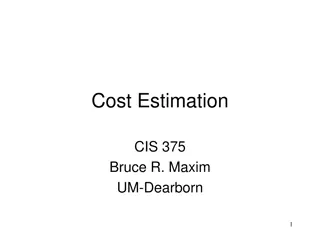Estimation of Hemoglobin by Sahli Method
This lecture covers the estimation of hemoglobin using the Sahli's/acid hematin method. The process involves mixing blood with N/10 HCl to convert Hb to acid hematin, diluting the solution to match a brown color standard, and reading the Hb concentration directly. Equipment, reagents, procedure, advantages, and disadvantages are discussed.
Download Presentation

Please find below an Image/Link to download the presentation.
The content on the website is provided AS IS for your information and personal use only. It may not be sold, licensed, or shared on other websites without obtaining consent from the author.If you encounter any issues during the download, it is possible that the publisher has removed the file from their server.
You are allowed to download the files provided on this website for personal or commercial use, subject to the condition that they are used lawfully. All files are the property of their respective owners.
The content on the website is provided AS IS for your information and personal use only. It may not be sold, licensed, or shared on other websites without obtaining consent from the author.
E N D
Presentation Transcript
Department of Anesthesia Techniques Title of the lecture: - ESTIMATION OF HEMOGLOBIN by Sahli s/acid hematin Method Asst.lec.Waleed Khalid Waleedalkhalid85@gmail.com
Principle: Blood is mixed with N/10 HCl resulting in the conversion of Hb to acid hematin which is brown in color. The solution is diluted till it s color matches with the brown colored glass of the comparator box. The concentration of Hb is read directly. Hemoglobin + (0.1 N) HCl Acid hematin (brown colour) The brown color of compound is matched against a brown glass standard in a comparator.
Equipment required Hemocytometer which consists of: 1. comparator box which has brown colored glass on either side 2. Hb pipette which is marked up to 20mm3(0.02ml blood) 3. Tube with markings of Hb on one side 4. glass rod 5. dropper
Reagents required N/10 HCl Distilled water Sample: Venous blood collected in EDTA as described earlier
Procedure 1. Placed 0.1(N)HCl acid in the Sahli s tube up to the lowest mark 20% by using a Pasteur pipette 2. Pipette 0.02 ml of blood in a Hb-pipette and added with the 0.1(N)HCl acid present in the Sahli s tube. Mixed well and wait for 10 minutes. 3. Diluted the solution with distilled water by adding few drops at a time carefully and diluted the solution, until the colour matches with the glass comparator present in the haemometer. 4. The colour matching should be done only against natural day light. The level of the fluid is noted at its lower meniscus and the reading corresponding to this level on the scale is recorded in gm/dl.
Advantages Easy to perform Quick Inexpensive Can be used as a bedside procedure Does not require technical expertise
Disadvantages Less accurate. All hemoglobins (oxyhemoglobin, sulphemoglobin) are not converted to acid hematin and hence the value of Hb obtained is less than the actual value. The color of acid hematin develops slowly. Color of acid hematin fades with time and dilution must be done exactly after 10 min when the color development is maximum Individual variation in matching of color is seen.
Hemoglobin Interpretation A. Increased values: Physiological High attitude. Young age. Pathological Dehydration.
B. Decreased values : Physiological Fluid therapy. Pathological Anemia. Hemorrhage. Blood parasites. Malignant tumors.
